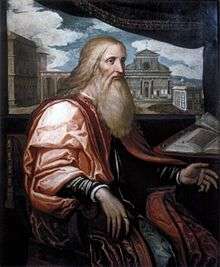Giovanni di Paolo Rucellai
Giovanni di Paolo Rucellai (1403–1481) was a member of a wealthy family of wool merchants in Renaissance Florence, in Tuscany, Italy. He held political posts under Cosimo and Lorenzo de' Medici, but is principally remembered for building Palazzo Rucellai, for his patronage of the S. Sepolcro chapel and of the marble façade of the church of Santa Maria Novella, and as author of the Zibaldone. He was the father of Bernardo Rucellai (1448–1514) and grandfather of Giovanni di Bernardo Rucellai (1475–1525).
Giovanni di Paolo Rucellai | |
|---|---|
 Patronage portrait of Giovanni di Paolo Rucellai, in the background his principal works in Florence: Palazzo and Loggia Rucellai, the façade of Santa Maria Novella and the Tempietto of the Holy Sepulchre. Oil on board, attributed to Francesco Salviati, c. 1540 | |
| Born | Giovanni Rucellai 1403 Florence |
| Died | 1481 Florence |
| Nationality | Florentine |
| Known for | Palazzo Rucellai, patronage of the arts, façade of Santa Maria Novella, the Zibaldone |
Life
Giovanni di Paolo Rucellai was born on 26 December 1403 to Paolo Rucellai and Caterina di Filippo Pandolfini, one of three children born in the 40 months of their marriage before the early death of Paolo Rucellai. As a young man, Giovanni di Paolo entered the banking house of Palla di Noferi Strozzi and at the age of about 25 married his daughter Iacopa di Palla Strozzi. The couple had two sons and five daughters. Rucellai remained loyal to Strozzi after the banishment of the latter to Padova by Cosimo de' Medici in November 1434, and for about 27 years he took no part in public life. However he became friends with Cosimo, and in 1461 his second son, Bernardo di Giovanni Rucellai, then about 13 years old, was married to Cosimo's grand-daughter Nannina de' Medici, daughter of Piero di Cosimo de' Medici and elder sister to Lorenzo. Nannina was brought to her husband's house five years later, on 8 June 1466. The wedding feast was famous for its opulence: 500 guests were seated on a dais which occupied the loggia and the whole of the piazza and the street in front of Palazzo Rucellai.[1]
Giovanni di Paolo was the effective head of the Rucellai family. He served as Prior in 1463 and as Gonfaloniere di Giustizia in 1475.
Patronage
Giovanni di Paolo was an important patron of the arts, matched only by Cosimo de' Medici in fifteenth-century Florence. He commissioned the building of the Palazzo Rucellai, designed by Leon Battista Alberti, and the Loggia Rucellai. He built a villa at Quaracchi on the road from Florence to Pistoia. His most notable donation, the marble façade by Alberti for Santa Maria Novella, was but one of the family's commissions of public art.[2] For the Palazzo Rucellai he commissioned works from Andrea del Castagno, Desiderio da Settignano, Filippo Lippi, Piero Pollaiuolo, Paolo Uccello, Verrocchio, Domenico Veneziano, Vittorio Ghiberti and Giovanni Bertini.[3]
The Zibaldone
Giovanni di Paolo Rucellai was well-acquainted with the classics and he kept a Zibaldone into which he copied his translations of passages from Greek and Latin authors such as Aristotle, Boethius and Seneca the Younger.[4]
References
- G[iuseppe Bencivenni] P[elli] (1772) Elogj degli uomini illustri toscani, Tom. II. Lucca: [s.n.] (in Italian).
- Felix Gilbert (1949) "Bernardo Rucellai and the Orti Oricellari: A Study on the Origin of Modern Political Thought": Journal of the Warburg and Courtauld Institutes, Vol. 12, p. 105
- Martin Wackernagel, Alison Luchs (trans.) (1981) The World of the Florentine Renaissance Artist: Projects and Patrons, Workshop and Art Market. Princeton: Princeton UP, pp. 226-29.
- Mario Emilio Cosenza (1962) Biographical and Bibliographical Dictionary of the Italian Humanists and of the World of Classical Scholarship in Italy, 1300-1800 Vol. 5 Boston: G. K. Hall.
External links